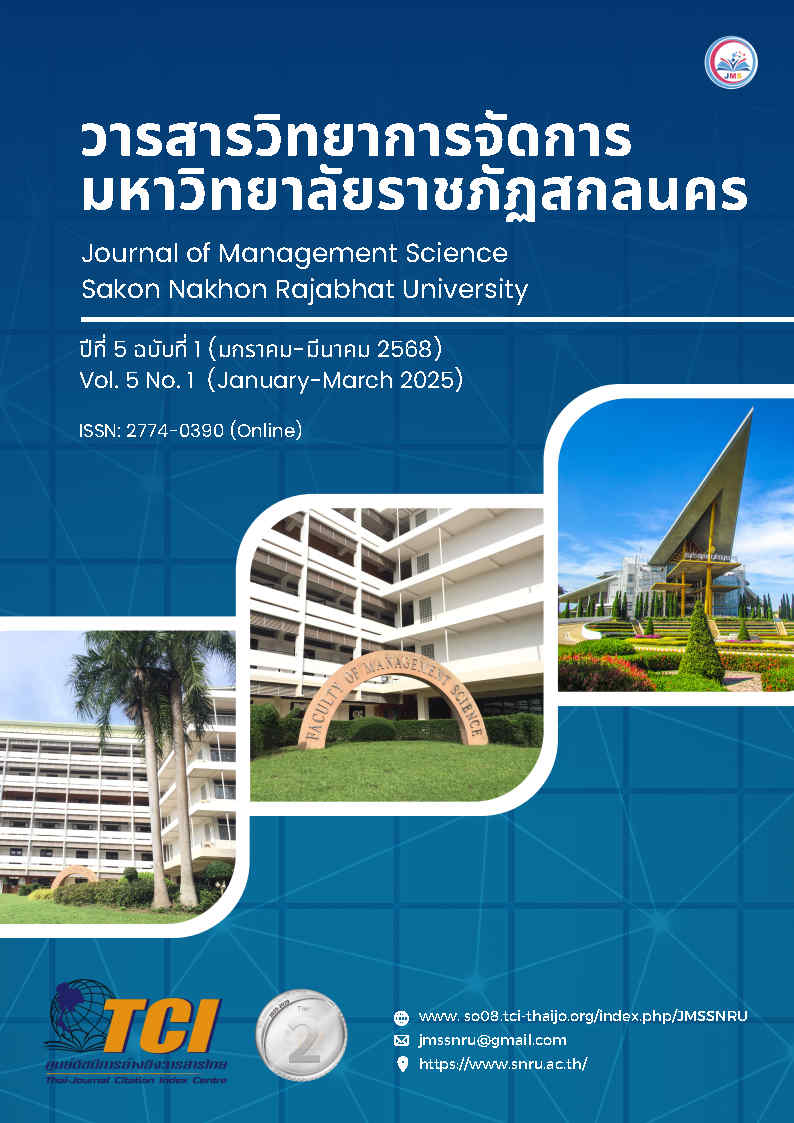Business models, consumer behavior and factors influencing purchasing decisions for commercialization of lansium domesticum extract facial serum products
Keywords:
purchase decision, skin care serum product, consumer behavior, business model, lansium domesticum extractAbstract
The objectives of this research were to study 1)business model and influence factors on purchasing Lansium domesticum extract for facial serum products and 2)consumer behavior and influence factors on purchasing Lansium domesticum extract facial serum products. The researcher conducted mixed-method research including interviewing 20 community enterprises and entrepreneur, and administering a questionnaire survey to 400 participants. The findings revealed that key factors in entrepreneurs' decision to purchase Lansium domesticum extract included quality certification, extract properties, extraction methods, and price. Suitable business models comprised community business groups, social enterprise models, and cooperative management structures. Regarding consumer behavior, most respondents were female, aged 41–50 years, who preferred using cream-type serums twice a day, containing various vitamins for skin hydration and dark spot reduction. People decided to buy commercial facial serums with Lansium domesticum extract based on three main factors: product qualities that did not cause allergic reactions or skin irritation were the most important; price and quantity were also very important; and approachable distribution channels were also important. Promotions and discounts were also considered significant factors.
References
กนกพร ฐานะเจริญกิจ และวรัญญา ติโลกะวิชัย. (2560). ปัจจัยที่มีผลต่อการตัดสินใจซื้อผลิตภัณฑ์บำรุงผิวหน้าของผู้บริโภคในเขตกรุงเทพมหานคร. การประชุมวิชาการเสนอผลงานวิจัยบัณฑิตศึกษาระดับชาติและนานาชาติ 2560. 10 มีนาคม 2560. ขอนแก่น: มหาวิทยาลัยขอนแก่น.
กัลยา วานิชย์บัญชา. (2540). การวิเคราะห์สถิติ: สถิติเพื่อการตัดสินใจ (พิมพ์ครั้งที่ 5). ภาควิชาสถิติคณะพาณิชยศาสตร์และการบัญชีจุฬาลงกรณ์มหาวิทยาลัย.
ปิยวรรณ ปาลาศ. (2563). การจัดการความรู้เพื่อพัฒนาและส่งเสริมผลิตภัณฑ์อัตลักษณ์ของจังหวัดอุตรดิตถ์สู่เชิงพาณิชย์: กรณีศึกษาลางสาดและกาแฟในระบบวนเกษตร. รายงานการวิจัย. กรุงเทพฯ: สำนักงานการวิจัยแห่งชาติ.
รัตพงษ์ สอนสุภาพ และบุญสม เกษะประดิษฐ์. (2561). ความมั่นคงของวิสาหกิจเพื่อสังคมเส้นทางสู่การพัฒนาอย่างยั่งยืน. วารสารสถาบันวิชาการป้องกันประเทศ, 9(3), 27-37.
เรืองเกียรติ สุวรรณโนภาส, ระพีพรรณ พิริยะกุล และนรพล จินันท์เดช. (2561). กลยุทธ์วิสาหกิจเพื่อสังคมวัฒนธรรมองค์การและการจัดการความรู้ที่ส่งผลต่อไตรสุทธิในวิสาหกิจเพื่อสังคมไทย. วารสารดุษฎีบัณฑิตทางสังคมศาสตร์, 8(3), 214-229.
สำนักงานปลัดกระทรวงมหาดไทย. (2548). คู่มือวิสาหกิจชุมชน. สำนักพัฒนาเศรษฐกิจชุมชน กรมการพัฒนาชุมชน.
สำนักงานส่งเสริมวิสาหกิจขนาดกลางและขนาดย่อม. (2561). วิสาหกิจเพื่อสังคม. สืบค้น 20 มิถุนายน 2561 จาก https://www.sme.go.th/th/promotion/social_enterprise.php.
Aaker, D. A. (1991). Managing Brand Equity. New York: Free Press.
Azhani, A. N., Abdullah, A. M., Zainol, Z., Omar, C. M. C., & Rahim, A. R. A. (2022). Factors influencing consumers' purchase intention towards halal cosmetic skincare products in Malaysia. SAGE Open, 12(1). https://doi.org/10.1177/21582440221078116.
Bradley, N., Dunlop, S., & Hare, C. (2022). The sustainable marketing mix. Taylor & Francis.
Defourny, J., & Nyssens, M. (2010). Conceptions of social enterprise and social entrepreneurship in Europe and the United States: Convergences and divergences. Journal of Social Entrepreneurship, 1(1), 32–53. https://doi.org/10.1080/19420670903442053.
Engel, J. F., Blackwell, R. D., & Miniard, P. W. (1995). Consumer behavior (8th ed.). Fort Worth, TX: Dryden Press.
Hawkins, D. I., & Mothersbaugh, D. L. (2010). Consumer behavior: Building marketing strategy (11th ed.). McGraw-Hill Irwin.
Hoang Cuu Long, Huynh Le Thuy Van, Dang Ngoc Khanh Thi, Oh Hyo and Nguyen Hoang Thu Trang. (2024). Factors Affecting Purchase Intention of Green Cosmetics Products Toward Young Generation in Ho Chi Minh City. International Journal of Science Academic Research. 5(1), 6830-6836. https://www.researchgate.net/publication/378032283.
Hoyer, W. D., MacInnis, D. J., & Pieters, R. (2013). Consumer behavior (6th ed.). Cengage Learning.
Kim, J., Park, S., Lee, K., & Choi, M. (2023). Factors influencing South Korean consumers' purchase decisions for skincare products. Korean Journal of Marketing, 31(2), 125-148.
Kotler, P., & Armstrong, G. (2018). Principles of marketing (17th ed.). Upper Saddle River, NJ: Pearson.
Kotler, P., Kartajaya, H., & Setiawan, I. (2019). Marketing 4.0: Moving from traditional to digital. John Wiley & Sons.
Kotler, P., & Keller, K. L. (2016). Marketing Management (15th ed.). Boston: Pearson.
Ko, W., Han, M., & Jang, E. (2022). A study on the regulations concerning the purchase related decision making factors of interest in beauty according to the cosmeceutical perception of the tendency for practical consumption. J-Institute. https://doi.org/10.22471/protective.2022.7.2.54
Krejcie, R. V., & Morgan, D. W. (1970). Determining sample size for research activities. Educational and Psychological Measurement, 30(3), 607-610.
Loudon, D. L., & Della Bitta, A. J. (1993). Consumer behavior: Concepts and applications (4th ed.). New YorK: McGraw-Hill.
Loureiro, S. M. C., Lopes, R., & Kaufmann, H. R. (2021). Organic cosmetic products: what determines European Western consumer purchase intention? The Service Industries Journal, 1-21. https://doi.org/10.1080/02642069.2021.2018301.
Osterwalder, A., & Pigneur, Y. (2010). Business model generation: A handbook for visionaries, game changers, and challengers. John Wiley & Sons.
Park, H., & Lee, J. (2014). Image and perceived quality of Japanese skincare products in South Korea. Korean Journal of Japanese Studies, 22(1), 62-81.
RajyaLakshmi, N. C. (2023). Consumer buying process for cosmetics-an analysis. Indian Scientific Journal of Research in Engineering and Management. https://doi.org/10.55041/ijsrem26208
Roscoe, J. T. (1975). Fundamental Research Statistics for the Behavioral Sciences (2nd ed.). New York: Holt Rinehart and Winston, Inc.
Schiffman, L. G., & Kanuk, L. L. (2007). Consumer Behavior (9th ed.). Upper Saddle River, NJ: Pearson Prentice Hall.
Schiffman, L. G., & Wisenblit, J. (2019). Consumer behavior (12th ed.). Upper Saddle River, New Jersey: Person Prentice Hall.
Solomon, M. R. (2017). Consumer behavior: Buying, having, and being (12th ed.). Upper Saddle River, New Jersey: Pearson.
Solomon, M. R. (2020). Consumer behavior: Buying, having, and being (13th ed.). New Jersey: Pearson.
THAIPUBLICA. (2566). Krungthai COMPASS วิเคราะห์ตลาดเครื่องสำอางไป ต่ออย่างไร เมื่อความสวยหยุดไม่ได้. สืบค้น 28 เมษายน 2567 จาก https://thaipublica.org/2023/04/krungthai-compass51.
Yamane, T. (1967). Statistics: An introductory analysis (2nd ed.). Harper and Row.
Zeithaml, V. A. (1988). Consumer perceptions of price, quality, and value: A means-end model and synthesis of evidence. Journal of Marketing, 52(3), 2-22.
Downloads
Published
How to Cite
Issue
Section
License
Copyright (c) 2025 วารสารวิทยาการจัดการ มหาวิทยาลัยราชภัฏสกลนคร

This work is licensed under a Creative Commons Attribution-NonCommercial 4.0 International License.
An article published in the Journal of Management Science. Sakon Nakhon Rajabhat University is the opinion, copyright and responsibility of the author of the work.






